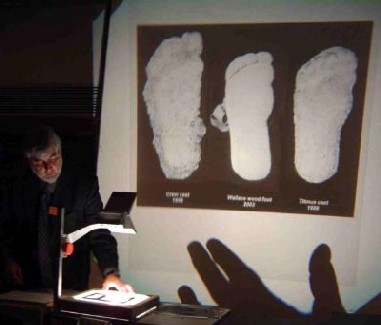
April 24, 2006
Roger Knights, the intellectually-aware Bigfoot correspondent to many, has followed a comment to my original “Bigfoot, Not Bigfeet” posting that deserves to be addressed separately, with room for more comments, here. He writes:
The Bords were as knowledgeable as anyone, and they used “Bigfeet” as the plural in their Casebook, and retained that usage in the version republished last year. (E.g., in the title of Ch. 7, on p. 121.)…A much better indication of a natural (unaffected) plural is the case of the Blackfoot tribe of Indians. The natural tendency of English-speakers is to refer to a group of them as Blackfeet. (Including you, hypocrite lecteur.) I Googled and found, near the top of the list, an informational website that regularly used phrases like, “The Blackfeet used dogs to drag travois,” etc. If Blackfoot/Blackfeet, then Bigfoot/Bigfeet.
Insistence on avoiding a plural form that comes naturally to the English-speaking population is what might lead them into the error of thinking that only one of the critter exists.
End of Knight’s comment.
Nothing comes so naturally to humans as an examination of their own being.
Humm, hypocrite lecteur = hypocrite reader? LOL

Okay, thusfar we have Ivan T. Sanderson, from Scotland, cleverly using “Bigfeet” as the chapter title (“The Appearance of Bigfeet”) in his 1961 book, and the Bords, like Sanderson, also from the U.K. (Wales), copycating him by using “Bigfeet” as a chapter title (“Phantom Bigfeet…”) in their 1982 book, and yes, now their 2005 reprint, Bigfoot Casebook Updated. (BTW, in the modern scanning-based publication of out-of-print Bigfoot books, it is more trouble than it is worth, financially, to change words like “Bigfeet” found embedded in the text of old volumes being reprinted.)
I’m North American (and even a bit Native American), and frankly, “Bigfeet” sounds too strange for my ears and won’t be coming out of my pen, unless I am convinced by more compelling arguments. I’m not yet so inclined, to date, by anything I’ve heard.
The Blackfoot/Blackfeet debating point, for example, does not fly. The precedent of the Blackfoot and Blackfeet cannot be used to justify the use of “Bigfeet” for more than one Bigfoot.
Blackfeet and Blackfoot are two names for different groups of Indians. The southernmost group of the Blackfoot Confederacy are technically called the “Blackfeet” and are the “Piegans” or “Pikuni” branch of these Natives, located in western Montana.
The recent posting at Cryptomundo about “Blackfeet Bigfoot,” for example, are about these group’s Montana sightings. The Pikuni are always referred to by the use of the seemingly plural form “Blackfeet.”
Meanwhile, the two other branches of the Blackfoot Confederacy are the “Siksika” and the “Kainah” (or “Blood”) and these residents of Canada are always referred to by the use of the visually and seemingly singular term “Blackfoot.” Thus you actually have two different groups of the Blackfoot Confederacy up north calling themselves “Blackfoot,” alone or in multiple situations.
Therefore, many Blackfoot are not always Blackfeet. It depends on where they live. In Montana, one individual in the Pikuna group is a Blackfeet. In Canada, a group of Siksika are Blackfoot.
Sorry, but I feel Roger Knights is confusing the names that people have given to themselves, as Native Americans and Native Canadians, which are their preferred names, and tried to apply it to our cryptid name-discussion here. But it is apples and oranges.
However, I tend to agree wholeheartedly with something that Roger Knights said earlier in this discussion, elsewhere: “I think violating the usage established for ‘foot/feet’ serves mainly as a sort of marker or ‘shibboleth’ of insider-hood at present.”
Or as I mentioned too, as Michael Taylor, San Francisco Chronicle staff writer, wrote in 1999: “Cognoscenti rarely use the plural ‘Bigfeet’.”
I’ll still go that calling more than one Bigfoot with the silly-sounding name “Bigfeet” clues me into people that are not close to our field of study, in more ways than one.
About Loren Coleman
Loren Coleman is one of the world’s leading cryptozoologists, some say “the” leading living cryptozoologist. Certainly, he is acknowledged as the current living American researcher and writer who has most popularized cryptozoology in the late 20th and early 21st centuries.
Starting his fieldwork and investigations in 1960, after traveling and trekking extensively in pursuit of cryptozoological mysteries, Coleman began writing to share his experiences in 1969. An honorary member of Ivan T. Sanderson’s Society for the Investigation of the Unexplained in the 1970s, Coleman has been bestowed with similar honorary memberships of the North Idaho College Cryptozoology Club in 1983, and in subsequent years, that of the British Columbia Scientific Cryptozoology Club, CryptoSafari International, and other international organizations. He was also a Life Member and Benefactor of the International Society of Cryptozoology (now-defunct).
Loren Coleman’s daily blog, as a member of the Cryptomundo Team, served as an ongoing avenue of communication for the ever-growing body of cryptozoo news from 2005 through 2013. He returned as an infrequent contributor beginning Halloween week of 2015.
Coleman is the founder in 2003, and current director of the International Cryptozoology Museum in Portland, Maine.
Filed under Bigfoot, Books, Breaking News, Cryptotourism, CryptoZoo News, Cryptozoology, Media Appearances, Pop Culture, Public Forum, Reviews, Sasquatch